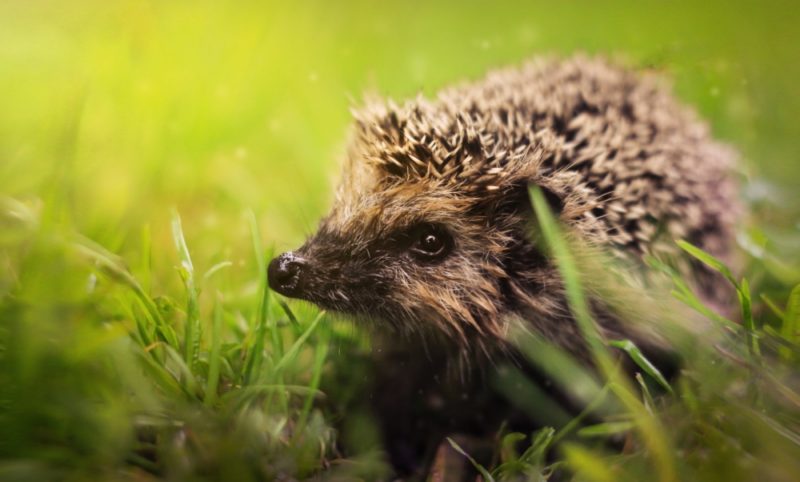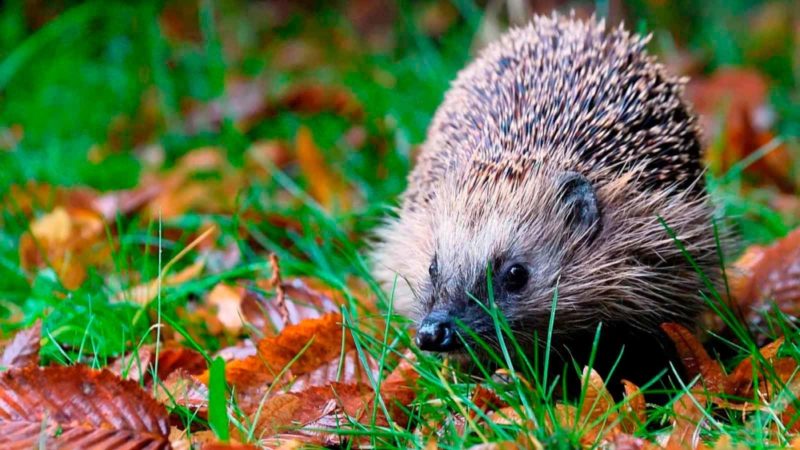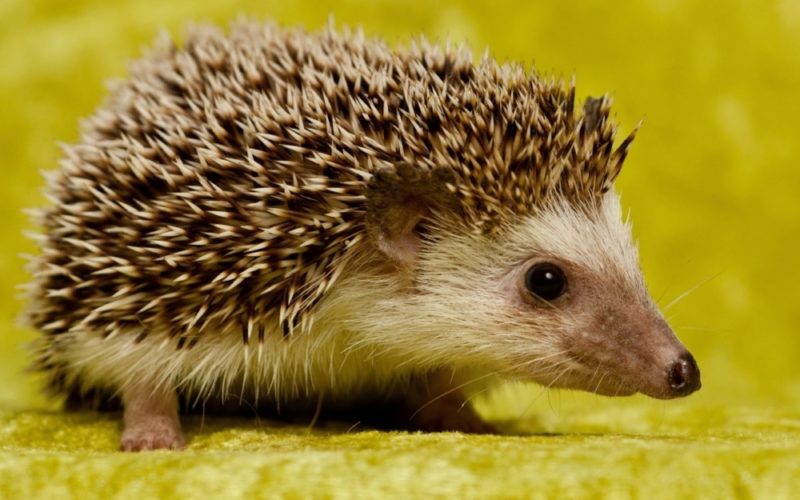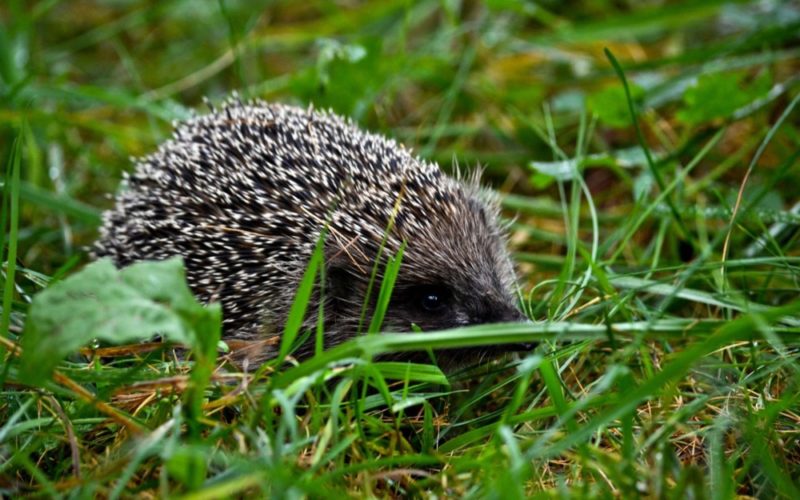Ordinary hedgehog is a funny and unusual animal, which still causes a lot of questions among zoologists. It is increasingly found not only in the natural environment, but also in the most ordinary apartments as a pet. About the habits of this cute prickly animal, as well as the features of its contents in the house, read in our article.
Material Content:
Description and features of an ordinary hedgehog
Ordinary hedgehog, or European, belongs to the insectivorous order, the hedgehog family.
A sexually mature animal has the following parameters:
- body length: 20 - 30 cm;
- weight: about 800 g;
- needle length: 2 - 3 cm;
- number of needles: 6 - 7 thousand;
- number of teeth: 36 (20 on the upper jaw, 16 on the lower).
The head, abdomen and limbs of the animal are covered with hair, the color of which varies from pale yellow to brown. The legs of the hedgehog are five-fingered, with sharp claws. The forelimbs are slightly shorter than the hind limbs.
The muzzle of the animal is elongated, the nose is dark, moist, the ears are small, up to 3 cm long. The teeth are small, sharp. The central pairs of incisors are elongated. There is a gap between the upper pair of incisors.
The head, back and sides of the hedgehogs are covered with hollow glossy needles. The color of the thorns is brownish with light stripes. Between the needles there is sparse wool.
Hedgehogs have poor eyesight, but have keen hearing and excellent sense of smell.
They are not timid, often explore new territories and are able to leave their nests up to 3 km away. Thanks to the developed muscles, in case of danger, the animals curl up into a tight lump. For a long time it was believed that male hedgehogs are hostile to each other and jealously guard their territory.However, recently this information has been doubted by zoologists. Most likely, males are aggressive only in the presence of a female.
Some interesting facts about hedgehogs:
- Modern species of hedgehogs have existed on our planet for several million years, while their appearance has not changed much during this time.
- Hedgehogs can travel at speeds of up to 3 m / s, swim and jump perfectly.
- In a year, only 1 needle out of 3 changes in a hedgehog.
- Hedgehogs are resistant to strong chemical toxins (arsenic, cyanide, etc.).
- In ancient Rome, the skin of an animal was used to make skin, and it was also grown for human consumption.
- Having met an object with a strong odor, the hedgehog licks it for a long time, and then secretes foamy saliva, which it puts on needles (presumably this is how the animal tries to get rid of skin parasites).
Scientists are not completely sure that all European hedgehogs belong to the same species. All these individuals are divided into two groups - light-breasted and dark-chested. They are slightly different in color, but have identical habits.
Lifestyle & Habitat
Hedgehogs settle alone. Animals become active with the onset of dusk, when they go to get their own food. During the day, they usually rest in a nest or other shelter. Hedgehogs arrange their home in the roots of trees left by rodents, minks, shrubs. The hedgehog covers the bottom of the nest with fallen leaves or moss.
From the end of summer, the animal begins to store fat for hibernation, which lasts from October to April. For wintering to be successful, the animal needs to gain about 500 g. During winter sleep, its body temperature drops to 1.8 ° C, and the respiratory rate is 1 breath per minute.
The animal awakens when the air temperature reaches 15 ° C. After leaving the hole, the hedgehog goes to look for food. After wintering, he is able to eat an amount of food equal to his body weight.
In Russia, the common hedgehog is found in Western Siberia and the European part of the country, as well as in the Amur Region. Animals live in Kazakhstan, the northern part of China, in central and western Europe.
The habitat of the hedgehog is quite diverse: the edges of deciduous and mixed forests, copses, river valleys. In Europe, the animal lives in the steppes, sandy areas, and even found in city parks. Avoids a hedgehog in swampy areas and dense coniferous forests.
Being a nimble and quick-witted animal, the hedgehog often settles next to people. In search of food, he often visits garden plots and courtyards of private houses.
Diet
Basically, the hedgehog eats insects, various worms and terrestrial mollusks (snails, slugs). He can also enjoy fruits, berries, small bird eggs.
Contrary to popular belief, hedgehogs do not prey on mice. The animal can kill and eat a vole caught in a trap, but he will not specifically track the victim. The adult hedgehog rarely eats rodents, but newborn mice can exterminate in significant quantities. Also, in rare cases, he can eat a numbed amphibian or small reptile.
Reproduction and longevity
The mating season in hedgehogs begins after hibernation is completed and continues throughout the summer. Several males gather around the female, who fight violently with each other. During the fight, the males use their needles, puff and snort, but do not cause serious damage to the enemy.
The winner circled the female for a long time, seeking her attention. Mating hedgehogs lasts several seconds, after which the male is removed. Males do not participate in raising offspring.
A pregnant female equips a nest for future hedgehogs. She occupies an empty hole of a rodent or digs her own; she covers the bottom of a house with grass, foliage or moss. Hedgehogs pregnancy lasts about 6 weeks.
Small hedgehogs are born blind, without hair and thorns with pink thin skin. In the litter, usually from 4 to 6 cubs with a body weight of not more than 20 g.A few hours after the birth of their first delicate needles break through. Finally, the thorny cover develops towards the end of the first month of life. Around the same time, the mother stops feeding the cubs with her milk. Animals reach sexual maturity by about a year.
In the natural environment, the hedgehog lives from 3 to 5 years. In captivity, the animal can live up to 10 years.
Home Content
The European hedgehog is an exotic pet, but caring for it does not require tremendous efforts. It must be kept in a spacious cage. For convenience, it should have two doors: a large one on top (for thorough cleaning) and a small one on the side (for serving food).
The following items must be placed in the home of the hedgehog:
- A small shelter. It is better to choose a plastic product, since a wooden shelter after numerous wet treatments will quickly become worthless.
- Running wheel. Hedgehogs are prone to weight gain, so they need exercise. The diameter of the wheel should be at least 30 cm, so that during running the back of the animal does not bend. The running part of the device itself must be integral, without crossbars.
- Bowl and drinker. For a hedgehog, heavy ceramic dishes with rounded edges are suitable, since the animal will constantly overturn the light container.
The bottom of the cage can be covered with dry grass, sawdust of deciduous trees, paper granules, shreds of fabric or wood filler for a cat's toilet. The flooring should be changed as it becomes soiled, once every 3 to 5 days.
Important! Sawdust of pine and other conifers cannot be used as flooring, since the hedgehogs' essential oils contained in them do not tolerate.
Most of the diet of a domestic hedgehog should be made up of live or frozen insects and worms, which can be purchased at the pet store. The animal is also offered lean boiled meat, fish, cereals, fruits and vegetables. Occasionally you can give him premium cat food. Dairy products for hedgehogs are contraindicated, as they can cause serious digestive upset or even cause the death of a pet.
A domestic hedgehog needs water treatments. They bathe the animal 1 time in 2 months in warm water using baby hypoallergenic shampoo. The needles are cleaned with a toothbrush. After the procedure, the skin of the animal is moistened with apricot or peach oil. To do this, 1 drop is applied to the back, back and withers.
Walking the animal in the apartment should be carried out under the control of the owner. A pet left unattended can become entangled in electric wires, get injured, get stuck in a narrow passage.
Unlike African hedgehogs, common hedgehogs living in captivity need 2 to 3 months of hibernation. Otherwise, the life span of the animal will be significantly reduced.
Before hibernation, he is well fed, since during his long sleep the animal loses up to half its own weight.
In order for the pet to hibernate, it is recommended closer to the fall to move its cage to a cool place, such as a loggia, a veranda, an attic or a barn. It is necessary to provide the animal with “building materials” for shelter: hay, dry foliage, pieces of cloth. In significant frosts (below -15 ° C), a hedgehog is best taken to the apartment. In case of awakening - feed.
Benefits and harm to humans
Hedgehogs bring significant benefits to gardeners. The animals destroy a large number of pests, saving the crop. It was for this purpose that the immigrants took them with them to New Zealand.
However, these animals destroy the offspring of birds building nests on the ground. So, on the British Isles, imported hedgehogs became a real disaster, significantly reducing the number of representatives of the snipe family.
This small animal is also a distributor of salmonellosis, rabies, dermatomycosis and some other formidable diseases. A lot of fleas and ticks, including encephalitis, accumulate in the needle cover of the hedgehog.
Enemies in their natural habitat
In nature, the animal has many enemies. Despite the fact that the special structure of the hedgehog allows him to curl up into a dense impregnable lump, animals often become victims of foxes, wolves, eagles or eagle owls. However, if the predator sees easier prey next to the hedgehog, he will not become involved with a prickly ball.
Red Book and Hedgehog
The hedgehog is listed in the Red Books of Moscow, Lipetsk, Sverdlovsk and Tomsk Regions. This animal is also under the protection of the Visimsky reserve (Sverdlovsk region).
Ordinary hedgehogs, the description of which is given in our article, have an incredible ability to adapt to changing environmental conditions. Perhaps that is why their ancestors, who appeared on earth 15 million years ago, were able to survive many extinct animals.



















